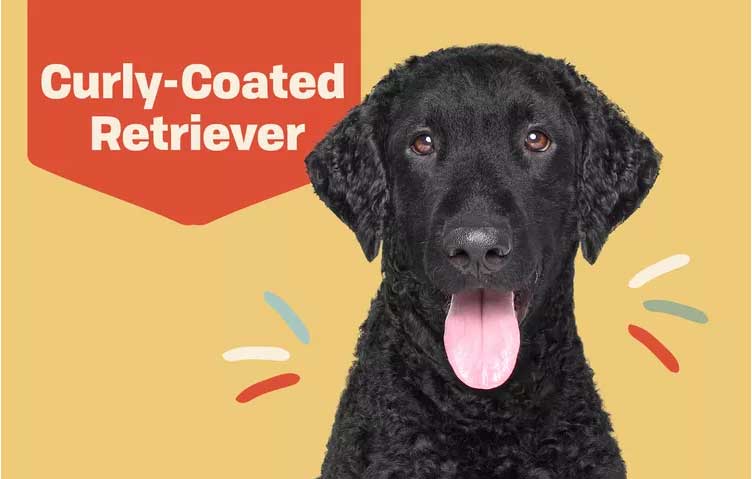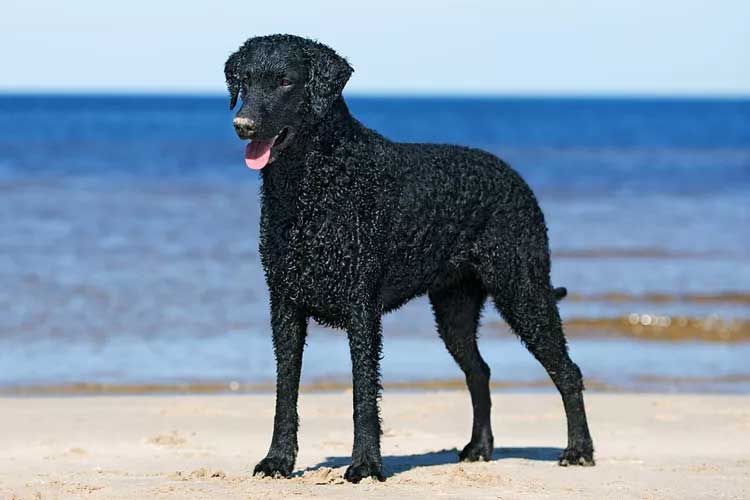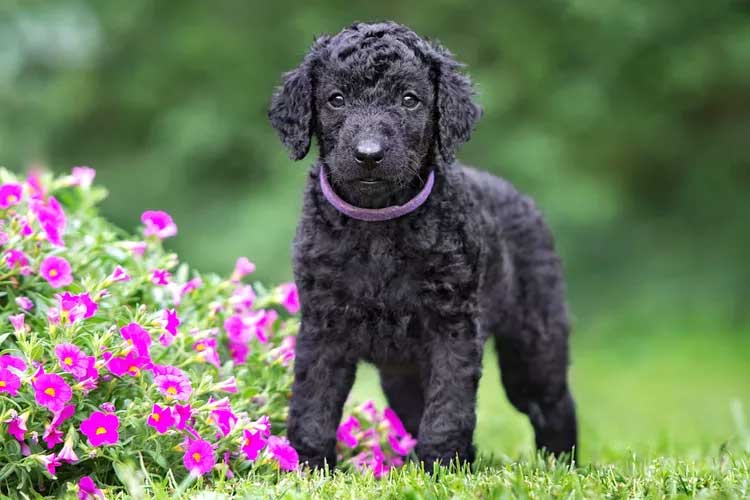Curly-coated retrievers are highly intelligent, energetic dogs that make great companions for outdoorsy families. Learn more about living with curlies.

Curly-Coated Retriever Overview
| OFFICIAL NAME | Curly-Coated Retriever |
| COMMON NAME | Curly-Coated Retriever |
| PET HEIGHT | 23 to 27 inches |
| PET WEIGHT | 60 to 95 pounds |
| LIFESPAN | 10 to 12 years |
| GOOD WITH | children, dogs, families |
| TEMPERAMENT | aloof, friendly, gentle, playful |
| INTELLIGENCE | high |
| SHEDDING AMOUNT | seasonal |
| EXERCISE NEEDS | high |
| ENERGY LEVEL | active |
| VOCAL LEVEL | when necessary |
| DROOL AMOUNT | low |
| BREED GROUP | sporting |
| BREED SIZE | large (61-100 lbs.) |
| COAT LENGTH | curly, medium |
| COLORS | black, brown / chocolate / liver |
| OTHER TRAITS | cold weather tolerant, easy to groom, easy to train, good hiking companion, high prey drive, loves water, strong loyalty tendencies |
Thanks to their signature curly hairdo that looks like a perm, curly-coated retrievers stand out in a crowd. These large, sturdy dogs are extremely intelligent and curious, which makes them quick studies during training sessions. They love to swim and run and, thanks to their thick, water-resistant coats and boundless energy levels, they'll happily go all day without getting tired or cold. Slightly more aloof and independent than other types of retrievers, curlies are confident, self-assured pups who make a great addition to active households.
"They're like a Lab, but a better watchdog, less friendly with strangers, and they have a curly coat," says Sarah Wooten, DVM, veterinary expert for Pumpkin Pet Insurance. "They are loving and affectionate with their family members, but less outgoing or clingy than golden or Labrador retrievers."
Appearance
As their name suggests, curly-coated retrievers have signature black or liver waves that make them stand out from other types of retrievers. They have a standard retriever-style build and body shape, but their coat might remind you more of a poodle or a Portuguese water dog.
Curlies have dense fur with small, tight curls that are distinct from one another—a bit like a perm! These curls cover most of their body, including up their neck, down their legs, and on their tails. Their ears are covered in curls, too, but they may be slightly looser and more relaxed. The only places where they have straight hair are their faces and the front parts of their legs. The dense mass of waves helps to protect the curly-coated retriever from the elements, which makes these dogs great hiking, swimming, and adventuring companions.
A typical curly-coated retriever stands 23–27 inches tall and weighs between 60–95 pounds. As with many dog breeds, females tend to be smaller than males, though not always. Curlies have black, brown, or amber eyes. Their ears are triangular and fall about halfway down the sides of their faces.
Temperament
Curly-coated retrievers are highly intelligent dogs with slightly different temperaments than other types of retrievers you're probably more familiar with. They tend to be more aloof around strangers when compared to their friendlier, attention-seeking cousin breeds like Labs and golden retrievers. This can make them a good fit for young professionals and busy families, though curlies are adaptable dogs who can fit into many types of households."Most pet parents would agree that the curly-coated retriever is less dependent on people than Labs and golden retrievers and that they can be a little more reserved," says Linda Simon, MVB, MRCVS, consulting veterinarian at FiveBarks.

Curly-coated retrievers love their families and enjoy spending time with them but can also tolerate being left alone. They're confident, affectionate, and active dogs. After a daily walk or play session, they'll also happily take a snooze on the couch.
Because they're so clever, curlies can become bored easily. It's important that they get enough exercise and are sufficiently mentally stimulated by training and activities like food puzzles and interactive toys.
Living Needs
Though they're adaptable dogs, curlies do best in living situations with plenty of room to roam—a house with a large fenced yard is a more ideal environment than an apartment or condo (though a smaller living space can work as long as their owner is committed to daily exercise).As active and intelligent hunting dogs, they need a lot of exercise to be content and well-behaved, Simon says. This also means that they do best with pet parents who have the time and energy dedicated to taking them on daily walks, runs, hikes, swimming excursions, or extended games of fetch.

"A minimum of 90 minutes each day will help keep the curly-coated retriever on an even keel and prevent them from becoming frustrated," Simon says. "They enjoy exploring on long walks and make excellent swimmers. These dogs won't tire from a game of fetch, and their skills in this game surpass most other breeds."
Curly-coated retrievers also excel at activities like obedience and rally, conformation, field, and agility, according to the Curly-Coated Retriever Club of America (CCRCA). Getting them involved in these types of doggy sporting events can help them burn off some of their energy and flex their brain power at the same time.
Curlies are great family dogs and they're very good with young children, though pet parents should always be around to supervise interactions between their curly and any little ones. Well-socialized curlies will also gleefully play with other dogs, particularly those they've been raised with or dogs they know well.
Care
Curly-coated retrievers are not only cute, but they're also relatively low-maintenance dogs. Their signature curls are totally natural and look their best when they're allowed to air-dry after a bath. And these dogs don't need baths very often, either, unless your pup has a penchant for rolling in mud puddles or getting particularly dirty at the dog park.Curly-coated retrievers shed throughout the calendar year and seasonally, which means investing in a metal, rake-style brush can be helpful for purging all of that dead hair to make room for fresh, new hairs. It's important to use this style of grooming tool, as brushing a curly-coated retriever's hair with other types of brushes can cause his beautiful curls to become frizzy. A simple trim with scissors periodically can also help keep this dog's hair in check.
All dogs walk and run their best when their nails are trimmed regularly, either with a grinder, clippers, or some combination of the two. You can trim your dog's nails at home or ask a trusted groomer to do it for an affordable fee.

Keep training sessions short and exciting if you want your curly to stay engaged, especially if you adopted a curly-coated retriever puppy. It's also beneficial to keep teaching curlies new behaviors and commands (with plenty of positive reinforcement like praise, treats, and pets along the way!) to help them exercise their brains.
"These dogs do best when rewarded for their efforts," Simon says.
Health
These dogs are a generally healthy breed, thanks to the diligence of responsible curly-coated retriever breeders over the years. They have average lifespans of 10–12 years.Curly-coated retriever breeders typically test their dogs for issues that can affect the eyes, heart, and hips, according to the CCRCA. They also perform specific DNA tests to screen for genetic issues like progressive retinal atrophy, exercise-induced collapse, and glycogen storage disease.
Curly-coated retrievers may be susceptible to certain cancers like lymphoma as well as bloat, also known as gastric dilatation-volvulus, which is a life-threatening stomach condition. In fact, some veterinarians recommend surgically tacking the curly-coated retriever's stomach to his abdominal wall (often during spay or neuter surgery) to help prevent bloat, Wooten says.
Taking care of a curly-coated retriever's teeth can also help keep this breed hearty and healthy. Brushing your dog's teeth at home each evening can be a fun way to bond with him. Depending on the individual dog's teeth, he may need regular deep-cleaning appointments at the vet, too. A veterinarian can examine a dog's teeth and help determine if and when professional cleanings are necessary. Dental chews can also help keep your curly's breath fresh and his teeth sparkling clean (plus, they're super yummy!).
Like other types of retrievers, curlies can easily become overweight if they eat too much or don't get enough regular exercise. A veterinarian can help you determine how much to feed your curly on a daily basis, based on his activity levels and size.
History
Curlies are believed to be one of the oldest retriever breeds in history. Though very few written records of the breed's lineage exist, dog historians believe they were developed during the 16th century. They may have been developed from Irish water spaniels and the now-extinct English water spaniels, retrieving setters, and St. John's dogs.According to the Curly-Coated Retriever Club, throughout the late 1800s the breed became popular among British hunters, who valued their high intelligence levels, weatherproof coats, soft mouths, and strong swimming abilities. They also soared in popularity in New Zealand and Australia during the late 1800s.
The breed was first introduced in the U.S. in 1907 and the first curly registered with the American Kennel Club in 1924.
Fun Facts
When it comes to the curly-coated retriever vs. Labrador retriever vs. golden retriever, curlies are not nearly as popular as their cousins. Labs and goldens are two of the most popular dog breeds, while curlies are rare pups.Like many other retriever breeds, curlies tend to shed moderately throughout the year with a noticeable increase in the spring and fall. Despite the curly-haired poodle, they are not considered to be hypoallergenic dogs and may not be the best fit for allergy sufferers.